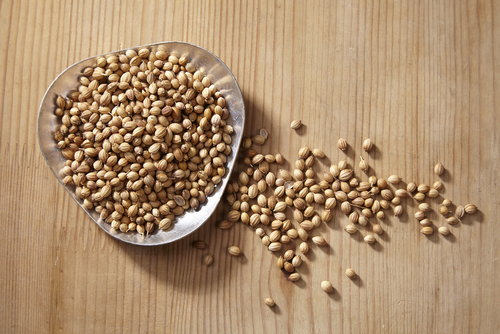Can you cut 1 Tonne of carbon pollution out of your life?
Take the challengeCoriander is one of those herbs that you either love or hate, and personally I love it! It's a temperamental little plant and over the years I've discovered a few tricks for growing it.
Originating in southern Europe and the Middle East, coriander gets its name from the Greek word for bug, 'koris', referring to the unpleasant smell of its unripe seeds. It has grown to be a popular herb around the world and is usually associated with Asian and Central and Southern American cooking.
Growing your own herbs and vegetables at home is a great way of lowering your carbon footprint by both reducing your food miles and your food waste by harvesting what you need when you need it. Here are some tips to get you started:

Tips for growing coriander:
Planting your seeds
- Seeds are best sown in Autumn or Spring.
- Each spherical seed casing contains two seeds and some people think it is best to gently break up the sed casing before planting to aid germination.
- Provide fertile soil that drains well.
- Plant around ½ cm deep, in rows 30cm apart, and thin to 15cm.
- Will grow well in containers.
- In hot regions grow in the shade. In cooler regions in the sun.
- Seeds may take a while to germinate so be patient.
Choose a variety that matches your purpose
Not all coriander is the same. You'll notice when you go to the nursery or online seed store that there is a slow bolting variety. This has better tasting and more abundant leaves with smaller seeds, whilst regular coriander has large seeds for use as a spice.

Avoid transplant shock by growing plants from seed or transplanting in large segments
Coriander is very sensitive to having its roots disturbed and grows best if you plant the seeds where you would like them to grow. If you do choose to purchase seedlings break them up into large segments to minimise root disturbance.
Select young healthy plants
If you are going to start with seedlings select healthy plants that are only a few centimeters tall. Ensure you choose healthy plants that don't show signs of pests or disease.
Give your plants space to grow
Once seeds are established or seedlings have settled in, thin seedlings out as coriander doesn't like to be overcrowded.
Prevent bolting by keeping your plants moist
Coriander has a habit of bolting to seed if it dries out. It's best to water it in the morning so it can dry off over the day because your plants won't be happy being water-logged either.
Succession Planting
Plant every 2 to 3 weeks for a continuous supply of coriander.

Grow it as a micro-green
For something different try growing coriander as a micro-green. Coriander is thought to be one of the top four micro-greens nutritionally.
Harvesting
The entire plant can be used and this can be harvested in one go, or the leaves can initially be used as a come-and-come-again herb. The best flavour will be while the stems are still soft and before the flowers have started to form. Harvest seeds as they begin to turn brown by cutting off the entire seed head and hanging them upside in a paper bag in a dry airy position. Once dry store them in an air-tight container. If well stored, seeds will last up to 3 years.
Where do I buy seeds?
Go to your local nursery or search for seed stores online. Try to buy seeds that have been grown in Australia. You could also join a local savers group or simply collect your own seeds to re-plant each season.
I'm going to plant some coriander in pots and in a tray for micro-greens this weekend!
Have you had success with growing coriander at your place? Do you have any tips or photos to share?

